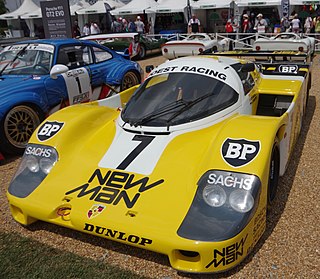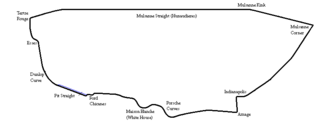
The Porsche 935 is a race car that was developed and manufactured by German automaker Porsche. Introduced in 1976 as the factory racing version of the 911 (930) Turbo and prepared for FIA-Group 5 rules, it was an evolution of the Carrera RSR 2.1 turbo prototype, the second place overall finisher in the 1974 24 Hours of Le Mans.

The 1996 24 Hours of Le Mans was the 64th Grand Prix of Endurance, and took place on 15 and 16 June 1996. It was won by a Tom Walkinshaw-Porsche prototype run by Joest Racing with drivers Davy Jones, Manuel Reuter and Le Mans rookie Alexander Wurz completing 354 laps. While not being the fastest car on track, it hit the front in the first hour and aside from several pit-stop overlaps, was never headed as other teams hit mechanical troubles during the race. This was Reuter's second Le Mans victory, and the first for Jones and Wurz, who, at 22 years old, became the youngest ever Le Mans overall winner.

The 1995 24 Hours of Le Mans was the 63rd Grand Prix of Endurance, and took place on 17 and 18 June 1995 in one of the wettest races in the event's history with about 17 hours of steady rain. The race was won by the #59 McLaren F1 GTR driven by JJ Lehto, Yannick Dalmas and Masanori Sekiya entered in the GT1 category. This was the first Le Mans win for a driver from Finland and for a driver from Japan. It was also McLaren's first win, at its first attempt - Ferrari had accomplished the same feat with its two cars in 1949, but other manufacturers like Jaguar, Porsche, Ford or Audi achieved their first Le Mans win only after 2, 3 or more attempts. As well as its outright win, the strength of the F1 GTR in the race was underlined by it ultimately filling four of the first five places.

The 1990 24 Hours of Le Mans was the 58th Grand Prix of Endurance, taking place at the Circuit de la Sarthe, France, on the 16 and 17 June 1990. Once again, the ongoing dispute between the ACO and the FISA governing body meant the race was not part of the World Sports-Prototype Championship. This was the last Le Mans run under the Group C formula, and a number of manufacturers put in a major effort to win, with the notable exception of defending winners Sauber-Mercedes.

The 1989 24 Hours of Le Mans was the 57th Grand Prix of Endurance, taking place at the Circuit de la Sarthe, France, on the 10 and 11 June 1989. This year it was not included as a round of the 1989 World Sports-Prototype Championship. The entry list promised a strong contest between five manufacturers. Jaguar had won in 1988 and went on to win the championship; while Sauber had finished second and was now matching Jaguar on the track. New regulations were coming in 1991, and the first examples of the 3.5-litre normally-aspirated formula were entered by Spice Engineering.

The 1988 24 Hours of Le Mans was the 56th Grand Prix of Endurance as well as the fifth round of the 1988 World Sports-Prototype Championship. It took place at the Circuit de la Sarthe, France, on the 11 and 12 June 1988. At their third attempt, Jaguar arrived with five cars to take on the strong Porsche works team of three cars, in their only race for the Championship season. The other potential rival was Sauber, now formally backed by Mercedes-Benz, but after a major high-speed tyre-blowout in practice, their two-car team was withdrawn.

The 1987 24 Hours of Le Mans was the 55th Grand Prix of Endurance as well as the fifth round of the 1987 World Sports-Prototype Championship. It took place at the Circuit de la Sarthe, France, on the 13 and 14 June 1987. Jaguar was a strong contender, have won the four preceding rounds of the Championship. The Porsche works team had installed a new 3-litre engine into their 962s but their turbo engines would test their fuel economy.

The 1986 24 Hours of Le Mans was the 54th Grand Prix of Endurance as well as the third round of the 1986 World Sports-Prototype Championship. It took place at the Circuit de la Sarthe, France, on 31 May and 1 June 1986. This year saw the return of a full Jaguar works team, to take on the strong Porsche works and customer teams. However, with the fuel regulations relaxed, the turbo-charged cars would be able to use more of their potential power to outrun the normally-aspirated 6-litre Jaguars.

The 1985 24 Hours of Le Mans was the 53rd Grand Prix of Endurance, as well as the fourth round of the 1985 World Endurance Championship. It took place at the Circuit de la Sarthe, France, on 15 and 16 June 1985. The works Porsche team returned, with a Group C version of the 962. As favourites, they could expect from their customer teams and the works Lancias. In qualifying, Hans-Joachim Stuck set a new lap record in his works Porsche, with an average speed over 250 km/h for the first time. Mercedes returned for the first time in 30 years, as engine supplier to the Sauber team. The return was short-lived though, as the car got airborne in practice and crashed. With tighter fuel regulations this year from FISA, the teams would have to be more mindful of fuel economy and speed. However, from the start the Joest and Richard Lloyd Racing teams had the measure of the field. Working in tandem, Klaus Ludwig and Jonathon Palmer took turns leading and slipstreaming behind the other. Then at 9pm Jean-Claude Andruet had a major accident when his WM had a tyre blow out a high speed at the Mulsanne kink, sending him into the Armco barriers. Andruet was uninjured, but the race went behind the pace-cars for a half-hour as repairs were done. Just as the race resumed James Weaver pitted the RLR Porsche with an engine misfire. Traced to a faulty sensor, they returned to the race in 7th.

The 1984 24 Hours of Le Mans was the 52nd Grand Prix of Endurance, and took place on 16 – 17 June 1984. It was also the third round of the 1984 World Endurance Championship. There were two big stories going into the race weekend: the absence of the Porsche works team and their drivers, and the return of Jaguar. Bob Tullius had commissioned the new Jaguar XJR-5 to run in the IMSA series and entered two for Le Mans. Earlier in the year, FISA had announced abrupt changes to the fuel regulations to bring them more in line with IMSA. Porsche and Lancia objected strongly because of their strong investment in the existing rules. In the absence of dominant Porsche works team, the race was left wide open between Lancia and the number of strong Porsche customer teams.

The 1983 24 Hours of Le Mans was a motor race staged at the Circuit de la Sarthe, Le Mans, France on 18 and 19 June 1983. It was the 51st Grand Prix of Endurance and was also the fourth round of both the 1983 World Endurance Championship and the 1983 European Endurance Championship. The 1983 race was held eight days before the 60th anniversary of the inaugural race held in 1923.

The 1982 24 Hours of Le Mans was the 50th Grand Prix of Endurance, which took place on 19 and 20 June 1982. It was also the fourth round of the 1982 World Endurance Championship. As well as a significant anniversary, this was a watershed year for Le Mans, with the highly anticipated advent of the FIA's Group C regulations, the essence of which was to allow an open engine formula but a minimum weight for safety and a proscribed fuel allocation.

The 1981 24 Hours of Le Mans was the 49th Grand Prix of Endurance, and took place on 13 and 14 June 1981. It was also the eighth round of the World Endurance Championship of Drivers, and the fifth round of the World Championship for Makes.

The 1980 24 Hours of Le Mans was the 48th Grand Prix of Endurance, and took place on 14 and 15 June 1980. It was the seventh round of both the World Championship for Makes and World Challenge for Endurance Drivers. With neither the Porsche nor Renault works teams contesting the big Group 6 sports-cars for outright victory, it left the prospects open for a privateer victory from Joest, Rondeau or De Cadenet, or from Group 5 again, if they were to fail. The wet weather throughout the race further added to the uncertainty, reducing the advantage of the more powerful cars.

The 1978 24 Hours of Le Mans was the 46th Grand Prix of Endurance, and took place on 10 and 11 June 1978. In many ways it was a continuation of the race from the year before – the two main protagonists would be the very evenly-matched works teams of Alpine-Renault and Porsche, with four cars each. The race was not valid for any championship.

The 1977 24 Hours of Le Mans was the 45th Grand Prix of Endurance, and took place on 11 and 12 June 1977. The second year of the FIA Group 5 and Group 6 regulations, it produced an exciting race right up to the end. Porsche had withdrawn from the Group 6 Championship, citing a lack of broad competition. Renault, before their move into Formula 1, decided to put its main racing focus for the year onto Le Mans. The two works teams were the pre-race favourites.

The 1976 24 Hours of Le Mans was the 44th Grand Prix of Endurance, and took place on 12 and 13 June 1976. This year the FIA introduced its new Group 5 and Group 6 regulations and the race was now open to nine distinct classes, although it was still not part of the World Championship seasons. Porsche introduced its new models, the 936 in Group 6, the 935 in Group 5 and the 934 in Group 4. In response, BMW had its modified 3.0 CSL in Group 5. It was the year that turbos arrived in considerable numbers, with over a dozen turbocharged entries, led by the Renault Alpine A442. It saw the arrival of French prototype manufacturers Jean Rondeau and Gérard Welter in a new GTP class and a first-time invitation to American IMSA and NASCAR entries.

The 1975 24 Hours of Le Mans was the 43rd Grand Prix of Endurance, and took place on 14 and 15 June 1975. Colloquially called the “Le Mans Economy Run”, stringent refuelling regulations were put in place. Unable to match the requisite 7mpg fuel economy the manufacturer teams from Ferrari, Alfa Romeo withdrew and Matra had retired from the sport at the end of 1974. Therefore, this only left Gulf and Ligier as front-running works-teams.

The 1974 24 Hours of Le Mans was the 42nd Grand Prix of Endurance, and took place on 15 and 16 June 1974. It was the fifth round of the 1974 World Championship for Makes. After Alfa Romeo had won the first race of the season at Monza, it had been Matra all the way and they came to Le Mans as firm favourites for a third consecutive outright victory, especially after Alfa Romeo withdrew its cars just before raceweek.

The 1973 24 Hours of Le Mans was the 41st Grand Prix of Endurance and took place on 9 and 10 June 1973. It was the eighth round of the 1973 World Championship of Makes.


















